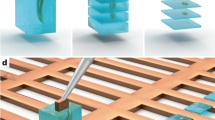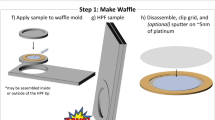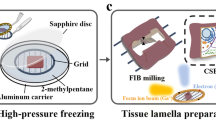Abstract
Cryo-focused ion beam milling of frozen-hydrated cells has recently provided unprecedented insights into the inner space of cells. In combination with cryo-electron tomography, this method allows access to native structures deep inside cells, enabling structural studies of macromolecules in situ. However, this approach has been mainly limited to individual cells that can be completely vitrified by plunge-freezing. Here, we describe a preparation method that is based on the targeted extraction of material from high-pressure-frozen bulk specimens with a cryo-gripper tool. This lift-out technique enables cryo-electron tomography to be performed on multicellular organisms and tissue, extending the range of applications for in situ structural biology. We demonstrate the potential of the lift-out technique with a structural study of cytosolic 80S ribosomes in a Caenorhabditis elegans worm. The preparation quality allowed for subtomogram analysis with sufficient resolution to distinguish individual ribosomal translocation states and revealed significant cell-to-cell variation in ribosome structure.
This is a preview of subscription content, access via your institution
Access options
Access Nature and 54 other Nature Portfolio journals
Get Nature+, our best-value online-access subscription
$29.99 / 30 days
cancel any time
Subscribe to this journal
Receive 12 print issues and online access
$259.00 per year
only $21.58 per issue
Buy this article
- Purchase on Springer Link
- Instant access to full article PDF
Prices may be subject to local taxes which are calculated during checkout




Similar content being viewed by others
Data availability
The in situ subtomogram averages of C. elegans ribosomes (EMD-4755 to EMD-4758), as well as the tomograms shown in Fig. 3 and Supplementary Fig. 5 (EMD- 4869 and EMD-4870), have been deposited in the Electron Microscopy Data Bank. Raw images can be requested from the corresponding authors upon reasonable request.
References
Frank, J. Three-Dimensional Electron Microscopy of Macromolecular Assemblies: Visualization of Biological Molecules in Their Native State 2nd edn, (Oxford Univ. Press, 2006).
Cheng, Y. F. Single-particle cryo-EM at crystallographic resolution. Cell 161, 450–457 (2015).
Beck, M. & Baumeister, W. Cryo-electron tomography: can it reveal the molecular sociology of cells in atomic detail? Trends Cell Biol. 26, 825–837 (2016).
Wan, W. & Briggs, J. A. G. in Resolution Revolution: Recent Advances in cryoEM (ed. Crowther, R.A) Ch. 13 (Acad. Press, 2016).
Guo, Q. et al. In situ structure of neuronal C9orf72 poly-GA aggregates reveals proteasome recruitment. Cell 172, 696–705 (2018).
Bykov, Y. S. et al. The structure of the COPI coat determined within the cell. eLife 6, e32493 (2017).
Albert, S. et al. Proteasomes tether to two distinct sites at the nuclear pore complex. Proc. Natl Acad. Sci. USA 114, 13726–13731 (2017).
Freeman Rosenzweig, E. S. et al. The eukaryotic CO2-concentrating organelle is liquid-like and exhibits dynamic reorganization. Cell 171, 148–162 (2017).
Mahamid, J. et al. Visualizing the molecular sociology at the HeLa cell nuclear periphery. Science 351, 969–972 (2016).
Arnold, J. et al. Site-specific cryo-focused ion beam sample preparation guided by 3D correlative microscopy. Biophys. J. 110, 860–869 (2016).
Rigort, A. et al. Micromachining tools and correlative approaches for cellular cryo-electron tomography. J. Struct. Biol. 172, 169–179 (2010).
Marko, M., Hsieh, C., Schalek, R., Frank, J. & Mannella, C. Focused-ion-beam thinning of frozen-hydrated biological specimens for cryo-electron microscopy. Nat. Methods 4, 215–217 (2007).
Rigort, A., Villa, E., Bäuerlein, F. J., Engel, B. D. & Plitzko, J. M. Integrative approaches for cellular cryo-electron tomography: correlative imaging and focused ion beam micromachining. Methods Cell Biol. 111, 259–281 (2012).
Schaffer, M. et al. Optimized cryo-focused ion beam sample preparation aimed at in situ structural studies of membrane proteins. J. Struct. Biol. 197, 73–82 (2017).
Villa, E., Schaffer, M., Plitzko, J. M. & Baumeister, W. Opening windows into the cell: focused-ion-beam milling for cryo-electron tomography. Curr. Opin. Struct. Biol. 23, 771–777 (2013).
Engel, B. D. et al. Native architecture of the Chlamydomonas chloroplast revealed by in situ cryo-electron tomography. eLife 4, e04889 (2015).
Rigort, A. et al. Focused ion beam micromachining of eukaryotic cells for cryoelectron tomography. Proc. Natl Acad. Sci. USA 109, 4449–4454 (2012).
Hsieh, C., Schmelzer, T., Kishchenko, G., Wagenknecht, T. & Marko, M. Practical workflow for cryo focused-ion-beam milling of tissues and cells for cryo-TEM tomography. J. Struct. Biol. 185, 32–41 (2014).
Delarue, M. et al. mTORC1 controls phase separation and the biophysical properties of the cytoplasm by tuning crowding. Cell 174, 338–349 (2018).
Harapin, J. et al. Structural analysis of multicellular organisms with cryo-electron tomography. Nat. Methods 12, 634–636 (2015).
Giannuzzi, L. A. et al. in Introduction to Focused Ion Beams: Instrumentation, Theory, Techniques and Practice (eds Giannuzzi, L. A. & Stevie, F. A.) Ch. 10 (Springer, 2005).
Langford, R. M. Focused ion beam nanofabrication: a comparison with conventional processing techniques. J. Nanosci. Nanotechnol. 6, 661–668 (2006).
Schaffer, M., Schaffer, B. & Ramasse, Q. Sample preparation for atomic-resolution STEM at low voltages by FIB. Ultramicroscopy 114, 62–71 (2012).
Mulders, P. & Trompenaars, P. Beam-induced deposition at cryogenic temperatures. European patent, EP2402477A1 (2010).
Mahamid, J. et al. A focused ion beam milling and lift-out approach for site-specific preparation of frozen-hydrated lamellas from multicellular organisms. J. Struct. Biol. 192, 262–269 (2015).
Zachman, M. J., Tu, Z., Choudhury, S., Archer, L. A. & Kourkoutis, L. F. Cryo-STEM mapping of solid-liquid interfaces and dendrites in lithium-metal batteries. Nature 560, 345–349 (2018).
Schaffer, M. et al. Cryo-focused ion beam sample preparation for imaging vitreous cells by cryo-electron tomography. Bio Protoc. 5, e1575 (2015).
Frangakis, A. S. et al. Identification of macromolecular complexes in cryoelectron tomograms of phantom cells. Proc. Natl Acad. Sci. USA 99, 14153–14158 (2002).
Chen, Y. X., Pfeffer, S., Hrabe, T., Schuller, J. M. & Forster, F. Fast and accurate reference-free alignment of subtomograms. J. Struct. Biol. 182, 235–245 (2013).
Bharat, T. A. M. & Scheres, S. H. W. Resolving macromolecular structures from electron cryo-tomography data using subtomogram averaging in RELION. Nat. Protoc. 11, 9–20 (2016).
Burnett, T. L. et al. Large volume serial section tomography by Xe plasma FIB dual beam microscopy. Ultramicroscopy 161, 119–129 (2016).
Moor, H. in Cryotechniques in Biological Electron Microscopy (eds Steinbrecht, A. & Zierold, K.) Ch. 8 (Springer, 1987).
Behrmann, E. et al. Structural snapshots of actively translating human ribosomes. Cell 161, 845–857 (2015).
Schaffer, M. et al. Protocol for cryo-focused ion beam lift-out technique. Protoc. Exch. https://doi.org/10.21203/rs.2.10392/v1 (2019).
Brenner, S. The genetics of Caenorhabditis elegans. Genetics 77, 71–94 (1974).
McDonald, K. et al. "Tips and tricks" for high-pressure freezing of model systems. Electron Microsc. Model Syst. 96, 671–693 (2010).
Rigort, A. et al. A 360º rotatable cryo-FIB stage for micromachining frozen-hydrated specimens for cryo-electron tomography. Microsc. Micro. 16, 220–221 (2010).
Mastronarde, D. N. Automated electron microscope tomography using robust prediction of specimen movements. J. Struct. Biol. 152, 36–51 (2005).
Zheng, S. Q. et al. MotionCor2: anisotropic correction of beam-induced motion for improved cryo-electron microscopy. Nat. Methods 14, 331–332 (2017).
Kremer, J. R., Mastronarde, D. N. & McIntosh, J. R. Computer visualization of three-dimensional image data using IMOD. J. Struct. Biol. 116, 71–76 (1996).
Hrabe, T. et al. PyTom: a python-based toolbox for localization of macromolecules in cryo-electron tomograms and subtomogram analysis. J. Struct. Biol. 178, 177–188 (2012).
Goddard, T. D., Huang, C. C. & Ferrin, T. E. Visualizing density maps with UCSF Chimera. J. Struct. Biol. 157, 281–287 (2007).
Acknowledgements
We are grateful to G. Pfeifer, I. Wolf, T. Matthes-Roesler and R. Gatz for technical support. We thank A. Zinke and A. Hyman (MPI-CBG) for providing the worm lines, A. Klingl and G. Wanner (LMU) for access to the high-pressure freezing instrument and J. Arnold for assistance with the cryo-confocal imaging and correlation. J.M. was supported by postdoctoral research fellowships from EMBO and HFSP, and by the Weizmann Institute Women in Science Program. We also acknowledge support from the Deutsche Forschungsgemeinschaft Excellence Clusters CIPSM and SFB 1035, the Max Planck Society and Thermo Fisher Scientific Company.
Author information
Authors and Affiliations
Contributions
M.S., W.B. and J.M.P. conceived and supervised the study. J.M.P. acquired funding and administered the project. M.S. and S.K. designed and developed the technique with support from T.L., A.R. and A.J.S. J.M. maintained the worm culture and performed HPF, cryo-ultramicrotomy and cryo-FLM. M.S. performed the cryo-FIB lift-out with technical support from S.K., T.L. and A.J.S. M.S. performed the cryo-FIB sample preparation with contribution from J.M. for the cryo-FLM correlation. M.S., J.M. and B.D.E. performed the cryo-microscopy work. S.P. developed the pipeline for the ribosome analysis. S.P. performed the data analysis and visualization with contributions from S.A. M.S., S.P., B.D.E. and J.M.P. wrote the manuscript with input from all authors.
Corresponding authors
Ethics declarations
Competing interests
S.K. is managing director of Kleindiek Nanotechnik GmbH. A.J.S. and A.R. are employees of Kleindiek Nanotechnik GmbH. All other authors declare no competing interests.
Additional information
Peer review information: Allison Doerr was the primary editor on this article and managed its editorial process and peer review in collaboration with the rest of the editorial team.
Publisher’s note: Springer Nature remains neutral with regard to jurisdictional claims in published maps and institutional affiliations.
Integrated supplementary information
Supplementary Figure 1 Instrument geometry during the lift-out preparation.
Schematic representation of the sample stage with the transfer shuttle, the cryo-gripper micromanipulator, the ion beam (IB, red) and the electron beam (EB, blue) in the FIB chamber, shown in isometric view (top) and side view (bottom) during the main steps of the preparation. The transfer shuttle has a pre-tilt of 45° and holds both the thick HPF bulk specimen and the thin TEM half-grid. The cryo-gripper is mounted with z-movement parallel and xy-movement perpendicular to the ion beam direction (red line), independent from stage rotation and tilt. It is aligned to the EB/IB coincidence point of the FIB. When not in use, it can be fully retracted. There are three main positions: A, Trench milling and lamella extraction from bulk HPF sample at 7° stage tilt and 0° stage rotation. The ion beam and gripping-plane are perpendicular to the HPF specimen surface. B, Cutting the lamella from the bulk material (except connecting bridges) at 28° stage tilt (the angle may vary, depending on the size of the lamella and trenches) and 180° stage rotation. The ion beam can access the bottom of the HPF specimen cross-section (lamella surface). The gripper is retracted to the parking position. C, Lamella insertion into the half-grid and final lamella thinning at 7° stage tilt and 180° stage rotation. The ion beam and the gripping-plane are parallel to the TEM half-grid surface and prepared slots.
Supplementary Figure 2 Lamella pockets fabricated by the FIB on a standard TEM half-grid.
A, SEM image of the half-grid with two sample pillars that have been modified by using ion beam milling and localized ion beam-induced Pt deposition at room temperature (‘OmniProbe’ half grids, Oxford Instruments NanoAnalysis, High Wycombe, UK). To produce the lamella pockets, first, two rectangle trenches are milled with a high current ion beam. Next, the slots are made by Pt deposition using four simple rectangle patterns. Finally, the slots are cleaned with a 5 nA ion beam. B,C, Magnified side (B) and top (C) views corresponding to the box indicated in A, showing a sample pillar with two lamella slots. D, Schematic representation of the modified TEM half-grid. E, Enlarged drawing of a specimen support pillar, in front and top views, showing areas of Pt deposition and milling. F, 3D rendering of a finished lamella pocket with a lamella inserted in the left slot position.
Supplementary Figure 3 The effect of conductive Pt coating on SEM imaging.
A, Two trenches have been milled around the area of interest with the ion beam perpendicular to the HPF specimen surface, and the lamella has been cut partly free with the ion beam (U-shape). In this step, the insulating frozen-hydrated material has been exposed and produces strong charging effects. B, After a conductive Pt sputter coating has been applied, charging is greatly reduced and imaging quality is improved. The experiment was repeated twice to obtain two ‘extraction-ready’ lamellae.
Supplementary Figure 4 Schematics of typical trench milling patterns with the ion beam perpendicular to the sample surface in order to produce a 3 µm thick volume of interest.
A, In the first step, two regular cross-section patterns (in yellow) are simultaneously milled on both sides of the region of interest using 1 nA beam current. The width of the pattern (24 µm) depends on the intended lamella width and should include approximately 10 µm excess width to accommodate the supporting area needed in the TEM half-grid as well as material loss during cutting. The height of the top pattern (8 µm) is required to allow insertion of the gripper. The height of the bottom pattern (20 µm) depends on the intended lamella height and must be large enough to allow a clear view of the cross-section (lamella surface) with the ion beam when cutting the lamella away from the bulk material. B, Next, both sides of the area are sequentially milled with a 0.5 nA beam current using a rectangular pattern and a tilt of 1° towards the lamella surface (darker regions indicate areas that have been milled). C, In a final step, both sides are milled with a tilt of 0.5° towards the lamella surface and a 0.3 nA beam current.
Supplementary Figure 5 Cryo-ET on a second FIB lamella of C. elegans tissue.
A, Cryo-TEM overview of a 150 nm thick cryo-FIB lamella prepared by the lift-out technique (2 tomograms were obtained from the lamella shown). B, x,y slice from a tomographic volume acquired at the framed area in A. C, Annotated representation of the tomogram in B. Ribosomes representing the p1-pre (blue), p1-post (yellow) and p2 classes (gray) were mapped back into the tomogram.
Supplementary Figure 6 Ribosome localization via template matching.
A, 500 ribosome-containing subtomograms were manually selected from one tomogram and iteratively aligned against a sphere as a starting reference (left). The subtomogram average converged to an 80S ribosome (right) within 10 iterations and could be subsequently used to generate a purely data-driven template for correlation-based ribosome localization. B, For template matching, the subtomogram average from A was downsampled to match the tomogram pixel size with 2x binning, and the 40S subunit head was removed using an ellipsoid mask as indicated by the blue sphere in A. This allows for efficient separation of true and false positives using subtomogram classification (see Supplementary Fig. 7a). C, Example cross-correlation function (red) obtained from template matching with the template shown in B. Putative ribosome positions are indicated by peaks in the cross-correlation function (red spots). Membrane-enclosed cellular compartments (gray) were superposed. D, Distribution of cross-correlation coefficients (CCC) for the 5000 highest-scoring peaks, which were extracted from the cross-correlation volume depicted in C while imposing a minimal Euclidean distance of 18.45 nm (9 voxels) between peaks. True and false positive matches were mostly separated and allowed for initial particle selection using a CCC cutoff, as indicated.
Supplementary Figure 7 Schematic illustration of the subtomogram analysis pipeline.
A, 13,688 aligned subtomograms retrieved by template matching were sorted into 5 classes. This allowed for separation of ribosome-containing subtomograms from false positives that lack the 40S subunit head not included in the template structure (upper row). Simultaneously, subtomograms were sorted into two different populations that were subsequently refined separately to 11.8 Å and 15.6 Å resolution (lower row). These populations mostly differ in the length of the resolved ribosomal RNA expansion segments, most prominently ES7L (red circle, see Supplementary Fig. 8). B, Further classification separated the ribosomes from population 1 into two different subpopulations that were refined separately to 13.7 Å and 12.3 Å resolution (lower row) and represent different states in the translational elongation cycle. Further classification of the ribosomes in population 2 did not yield structurally distinct subpopulations. Variability in resolution may be due to different tomogram acquisition schemes (see methods and Table S1). Alternatively, ribosomes contributing to population 2 might be translationally less active in general, which would also explain the absence of major subpopulations representing distinct translational elongation cycle states. C, Gold standard Fourier shell correlation (FSC) curves for ribosome population 1 (black), the pre- (red) and post-translocational states (blue) included in ribosome population 1, as well as ribosome population 2 (green). Resolution was determined using the FSC = 0.143 resolution criterion.
Supplementary Figure 8 Ribosome populations 1 and 2 differ in the length of the resolved surface-exposed eukaryote-specific ribosomal RNA expansion segments.
Difference density (red) between the two ribosome populations superposed on the subtomogram average of population 2 (gray). In the close-up views (bottom row), density for ribosome population 1 is superposed as blue mesh. Docking the atomic model of a mammalian 80S ribosome as a rigid body (light blue, PDB: 3j3f) reveals that the difference density almost exclusively co-localizes with surface-exposed eukaryote-specific ribosomal RNA expansion segments, including two arms of ES7L.
Supplementary information
Supplementary Information
Supplementary Figs. 1–8, Supplementary Table 1 and Supplementary Protocol
Supplementary Video 1
The cryo-FIB lift-out procedure: a small volume of interest is extracted from a high-pressure frozen sample and, using a micromanipulator, transferred onto a TEM half-grid for final cryo-FIB thinning. Correlative cryo-FLM is first used to target the area of interest in the otherwise topographically smooth bulk sample surface, followed by trench milling to obtain a ‘extraction-ready’ lamella, lift-out, positioning in a half-grid, Pt-GIS deposition and final thinning to electron transparency.
Rights and permissions
About this article
Cite this article
Schaffer, M., Pfeffer, S., Mahamid, J. et al. A cryo-FIB lift-out technique enables molecular-resolution cryo-ET within native Caenorhabditis elegans tissue. Nat Methods 16, 757–762 (2019). https://doi.org/10.1038/s41592-019-0497-5
Received:
Accepted:
Published:
Issue Date:
DOI: https://doi.org/10.1038/s41592-019-0497-5
This article is cited by
-
Self Fourier shell correlation: properties and application to cryo-ET
Communications Biology (2024)
-
Bridging structural and cell biology with cryo-electron microscopy
Nature (2024)
-
Ultrastructure of human brain tissue vitrified from autopsy revealed by cryo-ET with cryo-plasma FIB milling
Nature Communications (2024)
-
The application and development of electron microscopy for three-dimensional reconstruction in life science: a review
Cell and Tissue Research (2024)
-
Serial Lift-Out: sampling the molecular anatomy of whole organisms
Nature Methods (2023)



